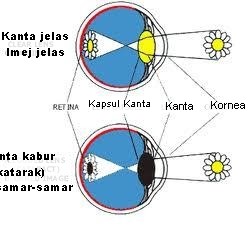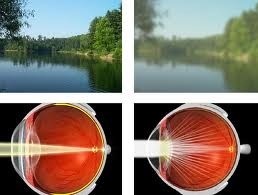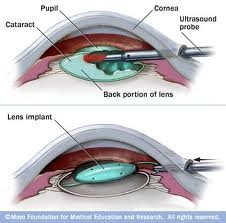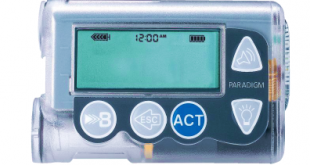What is Cataract?
Cataract is the clouding or fogging of the normal clear lens of the eye. Lens is the organ that allows us to see and focus an image just like a camera. A camera with clear lens shall give a beautiful picture and vice versa.
Diagram 1: Clear lens and Cataract
It is important to understand how we can see normally;
- Light rays enter the eye through the pupil
- and rays are focused through the lens onto the retina layer, the light-sensitive cells at the back of the eye.
- The focused image will be received as an impulse
- and the impulse is sent to the brain so that we see a clear image.
However, when the lens becomes cloudy or opaque, like what has occurred in cataract, the light will not be able to pass through, resulting in poor image formation or blurred sight.
Diagram 2: A clear lens versus cataract lens
Who is at risk to develop cataract?
There are many factors that may increase the risk of developing cataract such as;
- ageing process
- diabetes mellitus
- previous eye injury
- previous eye surgery, and
- long-term used of steroid (eye drop/inhaler/nasal spray).
However, the two most common factors are age-related and diabetes mellitus.
High blood sugar level in diabetic patients can cause the lens of the eyes to swell and cloudy thus preventing light from passing through the eyes. The cloudiness of the lens is what we called cataract. If the clouding or opacities is mild, your vision maybe slightly affected. If there are more clouding and affecting the entire lens, your vision will become severely limited.
What are the symptoms of cataract?
Most of the age-related cataract developed gradually. During the initial or early stages, you might not notice any signs or changes. As the cataract progress you may experience painless blurry or dim vision, hard to read, or drive a car, especially during the night because of glaring and frequent changes of glasses.
Diagram 3: Comparison of image perception of clear lens versus cataract lens
What are the complications of untreated diabetic cataracts?
Diabetic patients who are having bilateral cataract tend to have poor vision which affects their daily activities. This will cause more problems and injuries such as falling from the stairs and taking wrong medication due to impaired vision.
Many diabetic patients who are having cataract also have concomitant diabetic retinopathy. Diabetic retinopathy is the damage of the eye’s retina that occurs with long-term diabetes which can eventually lead to blindness. It will be difficult to view the retina through the cloudy or opaque lens, hence making the patient at risk of having progression of diabetic retinopathy without proper treatment.
What are the treatments?
A cataract may not need to be removed right away if your vision is mildly affected. In some cases, simply changing your eyeglass prescription may help to improve your vision. When a cataract causes significant vision problems that interfere with your daily activities, cataract surgery is recommended and the lens is replaced with an artificial lens implant. It is a quite common and safe procedure using ultrasound device to emulsify the lens (phacoemulsification). The procedure usually takes less than 30 minutes and can be done under local anesthesia. There are no medications or eye drops that will heal cataracts – surgery is the only treatment.
Diagram 4: Phacoemulsification
How to prevent diabetic cataract?
Patients with diabetes mellitus can lower their chances of getting cataracts if they maintain good blood sugar level and practice healthy diet. Generally, the higher the blood sugar level, the greater the risk for cataracts. A good diabetic control is also good to prevent diabetic retinopathy progression which is one of the commonest causes of blindness.
Reference:
Diagram 1: medicalpptonline.blogspot.com kisbyto.blogspot.com
Diagram 2: eye-surgery-advice.info
Diagram 3: harvardeye.com
Diagram 4: mayoclinic.com
Quiz
- What is cataract?
- lens cloudiness or opacity
- corneal opacity
- retinal opacity
Answer: A
- What is the symptom of cataract?
- pain
- blurring of vision
- squint
Answer: B
- How do we treat cataract?
- surgery
- taking medication
- taking herbs
Answer: A
 PENDIDIKAN PESAKIT Kementerian Kesihatan Malaysia
PENDIDIKAN PESAKIT Kementerian Kesihatan Malaysia







